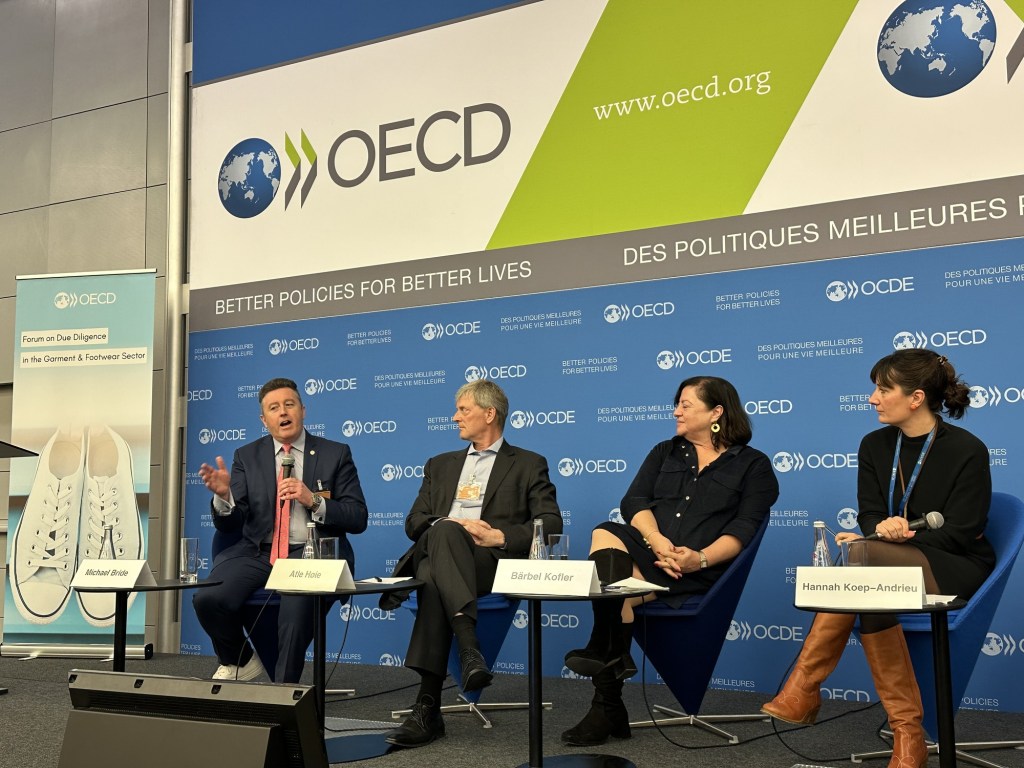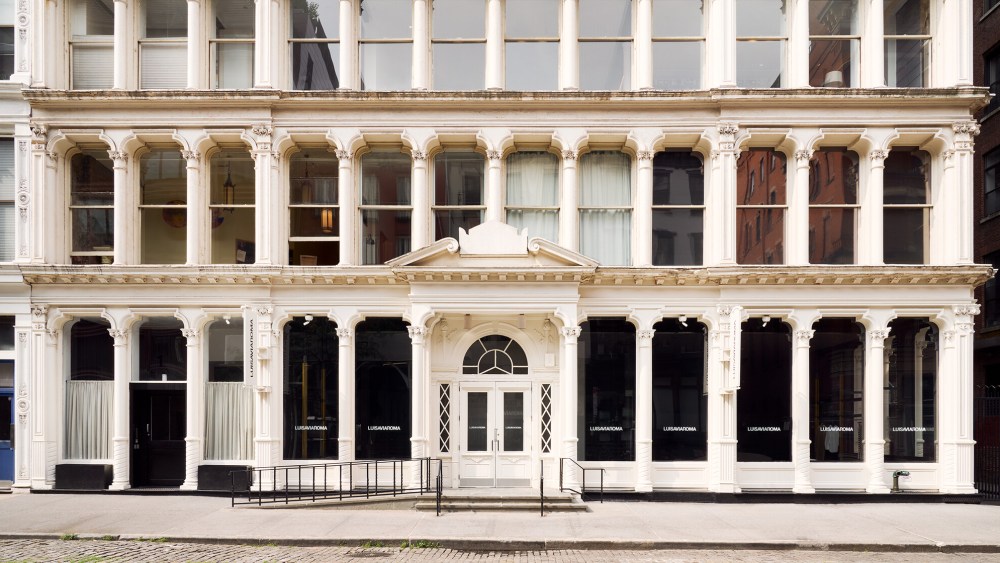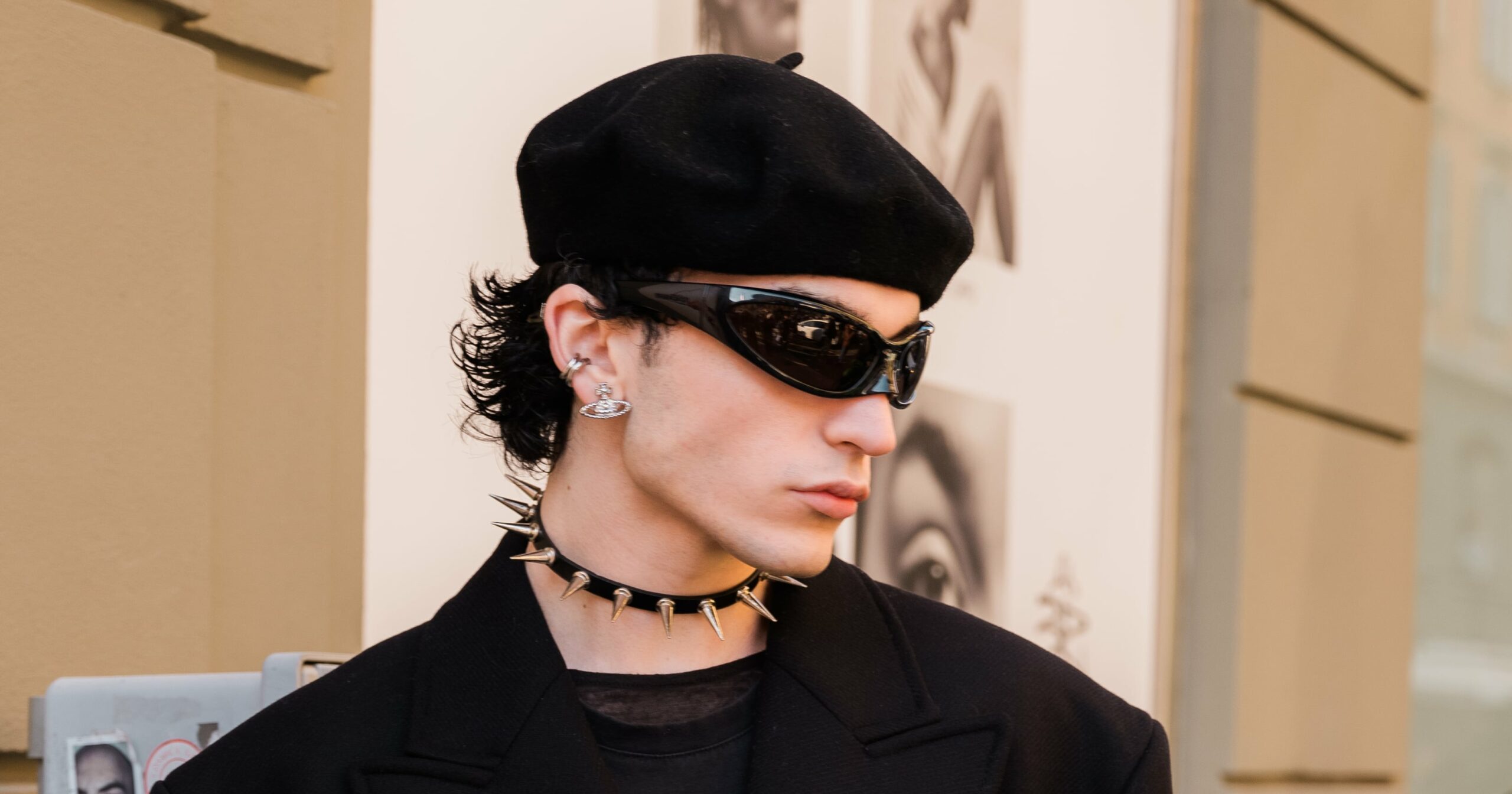PARIS — Brands are facing a rush of regulation that goes beyond collecting certifications and will have to dive deep into their supply chains to make structural change, even while they are reticent to pay up on many initiatives, said panelists at the OECD Forum on Due Diligence in the Garment and Footwear industry.
The event underscored the importance of the EU’s Corporate Sustainability Due Diligence Directive, which is currently stalled. Government and business leaders discussed the risks companies face — everything from losses associated with climate events to bad PR.
“This work is not easy. We are facing a rapidly evolving context and must meet complex global challenges. Despite easing inflation, the global economy continues to face weaker trade growth and lower business and consumer confidence. Furthermore, the climate crisis, as well as a surge in conflict continue to exacerbate risks and disruptions across supply chains, including in the garments and footwear sector,” said OECD deputy director for financial and enterprise affairs Antonio Gomes.
He noted that even as the EU legislation is stalled, 51 countries are operating under the OECD’s current due diligence framework for the industry, called the Garments Guidance. He called for consensus as a key building block for climate resilience and providing safe jobs around the world.
But the timing of the conference felt painful for many participants, who have been working with the expectation that the EU’s new overarching supply chain law would pass this year.
It was pulled Feb. 13, just a day before the scheduled approval vote after years of negotiations and previous preliminary approvals.
“We need the directive,” said German parliamentary secretary to the ministry of economic cooperation and development Bärbel Kofler, speaking during the opening session of the conference. “We are in a very challenging moment, and to be honest, I feel embarrassed.”
“We need this level playing field and we need to make it easier for our companies, so that we have 27 countries together in the same framework and not having different rules,” she said, citing similar but differing laws in Germany, France and the Netherlands.
The directive had passed the provisional agreement step in December, and February’s planned vote was widely viewed as the final stamp of approval. But just ahead of the planned vote, the German government announced it would abstain.
Kofler, a member of the Social Democratic Party, emphasized the country’s abstention was due to disagreement from the Free Democrats party, and said there is still time to bring it back to the table. The law would need to be finalized by the April parliamentary session, ahead of European elections in June.
“We are still negotiating, we don’t give up now,” she told WWD. “I just talked to the [representative] from the European Union who said there’s a hiccup in Germany, but the directive is still standing, so we are still working on it.”
Still, the suspended state of the legislation was the major topic of conversation during the coffee breaks of the two-day forum, which saw representatives from brands including Barbour, Disney and Uniqlo parent company Fast Retailing mingling with ministers and representatives of NGOs.
“I don’t think anybody saw this coming,” said one brand representative who was not authorized to speak on the record. “This was eight years of negotiating, longer than that, but eight years in real time, so civil society is now trying to grapple with what to do [next].”
Brands have been working on plans and protocols with the expectation that the CSDDD would go into effect in 2026, but are now in limbo.
“Germany says they are doing this to protect [small and medium-sized firms] but we need a level playing field,” said an official at one mid-sized German sportswear brand. The company is also trying to sort through the French laws, and had put an implementation process in place. “It would be better just to implement it. We can’t win.”
The law would hold companies headquartered or doing business in Europe accountable for any human rights or environmental abuses in their supply chain, widely seen as the EU extending its standards to producing countries outside of its bloc borders.
“Fashion is becoming a regulated industry,” said PVH Corp. senior vice president corporate sustainability, global affairs, Michael Bride. “So if you accept that, essentially, a company has three options: you can bury your head in the sand, you can do due diligence from the top down, or you can set a table and have a conversation with rights holders, and other folks and civil society and build a model with due diligence into your supply chain.”
“We are leaning into these things and a lot…it’s absolutely critical. We are not just signing these agreements to be, like, a ‘nice company,’” he said, explaining that it’s more about taking a preemptive approach to legislation coming at the fashion industry on many different fronts.
Bride said that with the accords, making all information publicly available is key to hold suppliers accountable, and brand pressure can improve standards across the board.
Investing in Solutions
Joy Roeterdink, head of corporate responsibility at global menswear retailer Suit Supply, said that as a private company they are not under investor, shareholder or market pressure, and have chosen to make investments with their long-term suppliers.
“Climate adaptations have been viewed from an investor perspective, and I think it’s important that continues, of course, [but] we’re taking a bottom-up approach,” she said. “We have more freedom.”
“We have seen this from a different angle, directly invading our own supply chain and noticing certain impacts at different levels. And things started to click,” she said of the company’s decision process.
Roeterdink said their production has been directly impacted by several climate-related events in recent years, including the Australian wildfires that impacted a wool supplier, floods in Italy that affected leather suppliers, and fires in Portugal that disrupted footwear production, among others.
Many companies are looking at “climate mitigation,” such as moving factories to new countries or finding suppliers in less impacted areas, but Roeterdink said working with artisans to regulate brand quality requires consistent engagement. Brands can’t just cut and run.
“We, in a lot of cases, are bound to either the land and communities for the craftsmanship that prevails in certain regions. With that comes sort of an inability also to just pick up and leave,” she said.
While Italy and Portugal aren’t classified as high-risk regions, for example, she said that following internal risk assessments, the company has realized they need to start “making these moves a bit sooner than others” if it wants to continue its global expansion as an accessible luxury brand.
The Netherlands-based company now has about 150 stores in China, as well as 36 units in the U.S. with ambitious growth plans there, she said.
While Suit Supply may have freedom to invest in its suppliers, there’s not quite as much maneuverability in the investment market, indicated Robeco senior engagement specialist Irina van der Sluijs.
The private asset management firm launched its first Fashion Engagement Equities Strategy in October to support change in the industry as it faces sustainability challenges ranging from its environmental impacts, GHG emissions, wage pressures and workers’ rights.
“We are engaging with retailers,” said van der Sluijs. While Robeco’s involvement “has some distance” from the brands on the ground, it can engage with companies to push for sustainable practices.
Institutional investors can drive change, she emphasized, noting that Robeco sets clear milestones, tracks progress and escalates issues to the board and participates in shareholder votes. The final step would be divestment, but van der Sluijs maintained that funds should stay involved and use their influence for good. “For us, we need leverage,” she said.
They are part of the investor collective Climate Action 100+, which is pushing for the companies it’s invested in to reduce emissions, she noted.
Through Robeco’s luxury and mass market investments, they are advocating for better product labeling and repair services, as well as scalable circular services, in addition to better sourcing policies.
However the fashion fund must also make a pure business case to their investors before pouring money into a company, and then must have demonstrable results on the other side. “We try to have some impact attribution toward positive impact that we can attribute directly to our engagement, because that is what our clients would like to see,” she said.
If concern about workers’ health isn’t enough to move the needle, said Jason Judd, executive director of Cornell’s Global Labor Institute, data shows how climate change impacts productivity. He worked with 12 well-known high-street brands, and said Levi’s is the only brand that has a protocol for how to handle worker safety on the increasing number extreme heat days in countries like Bangladesh and Pakistan. Loss of worker productivity, as well as damage to materials such as wool, has a demonstrable dollar value impact, he said.
Analyzing a “well-known European sportswear brand,” he said 1.5 to 3 percent of the brand’s assembled goods are likely to be impacted by high heat, resulting in a 5 to 15 percent hit to their net operating profit year-over-year by 2030. That research indicates that adaptive investments of hundreds of thousands of dollars will ensure millions of dollars of goods are protected, he said.
The Cotton Catch
Cotton wove its way through several panels, with discussions on everything from how to document practices at smallholder farms to labor rights to manufacturing to digital product passports.
Several panelists cautioned that many brands are focused on collecting certifications without engaging with producers in their supply chains. It then becomes a “paper exercise” rather than pushing for substantive change, they said.
G-Star Raw head of sustainability Rebecka Sancho said to avoid the certification trap, the brand is working with specific technologies like QR codes and pays a premium price for that cotton. The company is also experimenting with a technology that adds specific protein markers that cannot be duplicated within the cotton fibers. Then the fiber can be tested to trace back to an individual source.
“We have quite a lot of innovation,” she said. “I think we stand out compared to others in that the process information can be found on a product level.” Sancho reported that customers are not yet interested in such granular detail, but G-Star Raw is starting to communicate more on specifics, including types of dye and water usage, to raise overall consumer awareness.
Retailers Have Responsibility — and Leverage
Because of the wide range of brands they purchase, retailers are in a unique power position and can play a bigger role in driving responsible business practices throughout the industry, said panelists.
“It’s more broad than an individual approach,” said Sustainable Apparel Coalition executive vice president Andrew Martin. “That’s where the opportunity is to really drive change at scale.”
That can mean requiring supplier mapping and transparency, an ethical trade policy, recommended audits, specific certifications, and complying with a list of restricted substances, among other measures being implemented at retail platforms Asos and Zalando, executives said.
Both said they have strengthened their standards and vetting systems since getting caught up in a PR crisis when Boohoo, a brand they both carried, was exposed for labor and wage violations after an undercover investigation by the U.K.’s “The Sunday Times” in 2020.
“The most important thing that came out of this for us is vigilance, really understanding your risks, understanding areas of due diligence aspects, of the hot spots that you might have in the supply chain, whether it’s yours or whether someone else’s,” said Zalando head of sustainability stakeholder engagement Christian Smith.
Retailers can feel they are caught in a bind. If they are slow to communicate on these issues, they risk being held accountable when the brands they carry are called out, but they remain reluctant to talk about sustainability for fear of being accused of greenwashing.
Asos is a case in point, said the company’s head of branded engagement Jodie Leek, as it is under investigation from the U.K.’s Competition and Markets Authority for false eco-friendly claims. Berlin-based Zalando is in the process of overhauling its communications at the request of the EU, and will remove generic terms such as “sustainability” from its site and add more detailed and specific data on products.
Panelists acknowledged that there is an added cost to policing and setting up internal teams to improve external brand practices, which is a something retailers and platforms must grapple with as inflation makes shoppers look for the lowest price.
With that, Shein, Temu and other platforms that are constantly offering ever-lower prices were the unnamed elephants in the room. Under current legislation, they remain out of reach from the long arm of the EU’s reporting requirements, though some countries are trying to tackle that on an individual level.
Leather Looms Large
The EU’s anti-deforestation regulation, which will begin to take effect in December, will prohibit certain products on the European market if they have led to deforestation in their home countries. This includes leather, and puts in place supply chain traceability and proof of compliance requirements.
The main problem for producers sourcing raw skins from non-EU countries is traceability, as existing sustainability certification programs only start at the slaughterhouse, said Global Roundtable for Sustainable Beef executive director Ruaraidh Petre.
If traceability is to be as thorough as needed, it will need to be moved back through the entire life of each individual animal from birth, through each grazing area, several panelists said during a discussion on the impending regulations.
However current methods of identification, including branding, are not desired by luxury groups. “You don’t want a stamp or a mark on your luxury pair of shoes or handbags,” said Sustainable Leather Foundation managing director Deborah Taylor.
The technology for a digital identifier will need to be developed and implemented, but there is the bigger question of who will absorb that cost.
Gustavo Gonzalez-Quijano, secretary general of the European leather industry trade association Cotance, said estimates indicate that it would result in a cost increase of 2 euros per square meter of cow skin. But when that price was put forward to the market, there was “not a lot of demand,” he said.
“It might only be two euros, but the brands don’t want to pay that extra,” added Taylor. “There’s your problem. Industry can do it, we do have systems that we can adopt, but that money has to come into the value chain to enable it and nobody wants to pay for it.”



